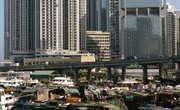Portuguese exploration along the West African coast began in the 15th century in the course of Portugal's search for a shorter route to Asia. Although trade with the Africans had not been the goal of their voyage, the Portuguese found that Africa had much to offer. African cities rivaled those of Europe in organization, and African agricultural systems were significantly advanced. The Africans had desirable goods to trade including ivory, gold and pepper. By the 1600s, however, the kingdoms of Africa had established trade with the Portuguese in a far more lucrative export: African slaves.
Lords of the Sea
In the 15th century, Portugal was a formidable power in world trade. Prince Henry the Navigator, an accomplished Portuguese navigator, ship builder and map maker, was instrumental in establishing trading forts along Africa's west coast. In 1498, the Portuguese explorer Vasco da Gama found a sea route to India, sailing around the Cape of Good Hope, the southernmost tip of Africa. This discovery and the expertise of Portuguese sailors in battle allowed Portugal to overpower trade competitors on both the east coast of Africa and throughout the Asian trading empire. In the mid-1500s, Portuguese supremacy in the Asian market was challenged and ultimately usurped by the Dutch East India Company. Portugal's position in Africa, however, remained strong.
A Culture of Slavery
Portuguese explorers were aware of the abundance of gold in the West African empires, and it was trade in this precious metal that originally attracted their interest. However, the social organization of Africa made the transition from trading gold to trading slaves an easy one. Within Africa, enslavement often was the punishment for a crime. Prisoners taken during tribal wars also became enslaved. Wealthy Africans traded slaves for gold. The Portuguese originally kidnapped Africans as slaves, but soon realized a system of slave-trading was already in place among the African people. The Africans were amenable to trading slaves with the Portuguese and did not calculate, at least initially, the damage the slave trade would have on their own population.
An Old World Institution
At the outset, the Portuguese slave trade was an exchange between African nations and European ones. Prince Henry the Navigator established a slave fort at Arguin Bay in Mauritania in 1445, and by the 1470s, Lisbon, Portugal's capital, had become the country's main slave trading center. Initially, most slaves were placed in domestic service in Portugal and Spain. By the end of the 15th century, however, the establishment of sugar cane plantations on the Atlantic Islands had created an overwhelming demand for slave labor. In 1539, about 12,000 slaves were traded in the Portuguese market. At the same time, Portugal was profiting from the export of Portuguese goods to Africa.
Expansion and Decline
The Portuguese discovery of Brazil in 1500 and the eventual establishment there of sugar plantations expanded the need for slave labor. The slave trade soon became transatlantic and, by the mid-1500s, West African slaves replaced indigenous peoples on Brazil's sugar plantations. At the same time, the Portuguese extended their slave-trading operations to Africa's East Coast, in the areas of Mozambique, Ethiopia and Madagascar. By the later 1500s, however, African resistance to the Portuguese was brewing. Portuguese settlements on the East Coast came under attack and war erupted in Angola. The Swahili revolted against the Portuguese on the East Coast in 1585. By the early 1600s, African rebellions and competition from other European traders caused a dramatic decline in the Portuguese slave trade.
Related Articles
References
Resources
Writer Bio
Laura Leddy Turner began her writing career in 1976. She has worked in the newspaper industry as an illustrator, columnist, staff writer and copy editor, including with Gannett and the Asbury Park Press. Turner holds a B.A. in literature and English from Ramapo College of New Jersey, with postgraduate coursework in business law.











